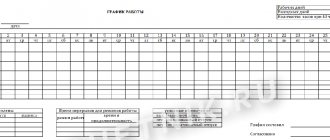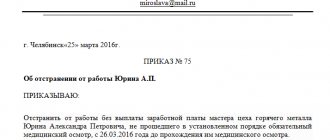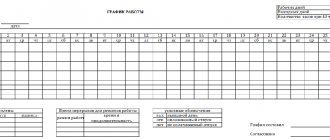What is it needed for
The shift schedule allows the company to ensure long-term daily activities. By regulating the order of one employee with another, the organization functions continuously. It uses existing production capacity optimally, increasing production volume. 2-, 3-, or 4-shift work is required to maximize profits. Each option has a strict time frame.
The document is needed to prevent downtime of production facilities. It is used in emergency organizations - medical, emergency situations, police. It is used to regulate the work of watchmen.
The document allows you to take into account the working hours of employees and correctly calculate wages. Control authorities must check its presence in the organization and, if not, apply penalties.
The main legislative act that determines the formation is the Labor Code of the Russian Federation (Articles 103 and 372). It does not contain a definition of the term, but establishes in a number of articles the basic requirements for the labor organization process:
- establish a break for meals (Article 108 of the Labor Code of the Russian Federation);
- provide for a duration of continuous rest every week of at least 42 hours (Article 110 of the Labor Code of the Russian Federation);
- do not engage an employee for 2 shifts in a row (Article 103 of the Labor Code of the Russian Federation).
When and who compiles
The decision on introducing or changing the shift schedule is within the competence of the employer. He makes a decision taking into account:
- technologies used in production;
- the need to improve process efficiency;
- exceeding the duration of production activities over the permitted duration of daily work;
- increasing the volume of products and services.
The employer assigns the task of formation to a personnel service employee, secretary or department head. The main condition for the contractor is to comply with legal requirements regarding the interests and rights of employees when developing a document.
How to determine quantity
The shift lasts from 3 to 12 hours during the day. The quantity is determined by the employer depending on the characteristics of the production process. The document is used throughout the year or season - when demand increases. The number of employees per shift is not limited.
As a rule, a sample of how to draw up a work schedule for 3 people for 12 hours each determines the direct order of rotation of employees (the first is worked - rest - inclusion in the second, third, etc.) or the reverse (first is worked - rest - inclusion in the third, then - to the second, etc.). If there is a continuous process, the enterprise uses a 4-step algorithm (3 shifts work 24 hours, the fourth is on vacation).
When determining the number of shifts and employees employed in them, the employer takes into account the permitted length of working time for special categories defined by Art. 94 of the Labor Code of the Russian Federation, and the employee’s reduced working hours.
Work schedule 4 4 it's like
1.7. Good afternoon This issue is not regulated by law. And according to the general rule, if the legislation does not have rules regulating a certain type of legal relationship, then they are regulated by traditions and rules of business turnover. In Russian law, eliminating a gap in legislation is carried out by adopting a normative legal act by the competent government body. However, it is not always possible to quickly eliminate gaps in the law, since they are related to the rule-making activities of the state. But law enforcement agencies cannot refuse to resolve a specific legal case due to the absence of a legal norm in the legislation. In cases where the rule-making body has failed to fill the gap, the rule of application of the institution of analogy is used. The use of the institution of analogy does not mean an arbitrary solution to specific cases. The law enforcement agency makes a decision in accordance with the general principles of law. https://jurisprudence.club/teoriya-gosudarstva-prava-uchebnik/165-probelyi-zakonodatelstve-sposobyi.html General principles of law - legal relations arising between employees and employers are regulated by the Institute of Labor Law. In general practice, issues of this nature are regulated by local regulations. Labor Code of the Russian Federation Article 8. Local
regulations containing labor law norms (as amended by Federal Law No. 90-FZ of June 30, 2006) (see text in the previous edition) Guide to personnel issues.
Questions of application of Art. 8 of the Labor Code of the Russian Federation Employers, with the exception of employers - individuals who are not individual entrepreneurs, adopt local regulatory acts
containing (hereinafter referred to as local regulatory acts), within their competence in accordance with
labor legislation and other regulatory legal
acts containing labor law norms , collective agreements, agreements. In cases provided for by this Code, other federal laws and other regulatory legal acts of the Russian Federation, collective agreements, agreements, the employer, when adopting local regulations, takes into account the opinion of the representative body of employees (if there is such a representative body). A collective agreement or agreements may provide for the adoption of local regulations in agreement with the representative body of workers. Norms of local regulations that worsen the situation of workers in comparison with established labor legislation and other regulations containing labor law norms, collective agreements, agreements, as well as local regulations adopted without observing the procedure for taking into account the opinions of the representative body of workers established by Article 372 of this Code , are not applicable. In such cases, labor legislation and other regulatory legal acts containing labor law norms, collective agreements, and agreements are applied.
Mandatory requirements
There is no established form of shift schedule; accordingly, the employer uses an arbitrary option. It is convenient to present it in the form of a table that includes the following information:
- number and date of formation;
- Full name, positions of employees;
- distribution of shifts during the week for each day;
- number of shifts per day;
- shift duration, start and end times, lunch break.
If necessary, the shift for the employee is specified (if it is not specified in the employment agreement - first or second, morning or evening). Based on this, a work schedule table is drawn up in 4 shifts of 12 hours day-night or another schedule.
| Employee's name | Personnel Number | Distribution of shifts by day of the week | ||||||||||||||
| 1 | 2 | 3 | 4 | 5 | 6 | 7 | 8 | 9 | 10 | 11 | 12 | 13 | 14 | 15 | ||
| 16 | 17 | 18 | 19 | 20 | 21 | 22 | 23 | 24 | 25 | 26 | 27 | 28 | 29 | 30 | ||
| Petrov P.P. | 10 | I | I | I | I | I | IN | IN | II | II | II | II | II | IN | IN | I |
| I | I | I | I | IN | IN | II | II | II | II | II | IN | IN | I | I | ||
| Sokolova S.S. | 15 | II | II | II | II | II | IN | IN | I | I | I | I | I | IN | IN | II |
| II | II | II | II | IN | IN | I | I | I | I | I | IN | IN | II | II | ||
The document should be agreed upon with the trade union of the organization according to the algorithm. 372 of the Labor Code of the Russian Federation[/anchor] and approved by a local administrative act. If the institution has a collective agreement, the document is an appendix to it (Part 3 of Article 103 of the Labor Code of the Russian Federation).
The employer familiarizes employees with the document at least 1 month in advance. Familiarization options:
- in a special signature column provided in the table with the schedule;
- on the familiarization sheets (in this case, the details of the sheets are indicated).
When planning your work, fulfill a number of conditions:
- do not assign an employee to 2 shifts in a row;
- provide uninterrupted rest for at least 42 hours per week;
- do not exceed the maximum permissible shift duration (Article 94 of the Labor Code of the Russian Federation) for certain categories;
- shorten the shift before the holiday by 1 hour (Article 95 of the Labor Code of the Russian Federation), taking into account the exceptions specified in Part 2 of Art. 95 Labor Code of the Russian Federation;
- reduce the duration of the night shift (from 22-00 to 6-00) by 1 hour without working hours (Article 96 of the Labor Code of the Russian Federation), taking into account the exceptions specified in parts 3, 4 of Art. 96 Labor Code of the Russian Federation;
- do not include overtime (except for cumulative accounting).
The document storage period is 5 years, except for the option of work with harmful and dangerous conditions. This option should be stored for 75 years. The period is counted from January 1 of the year following the one in which the schedule ends (Part 1, Article 17, Article 21.1 of the Law on Archival Affairs).
The absence of a document will lead to administrative liability in the form of fines of up to 75,000 rubles under Parts 1 and 2 of Art. 5.27 and art. 13.20 Code of Administrative Offenses of the Russian Federation.
Shift work schedule
mons.ksenia, Look at the website ***.mnogosmenka.ru There are some good articles on this topic. Shift work Valentina Vasilievna MITROFANOVA, director of the Subscriber Service Center for Labor Law, senior lecturer at the Department of Labor Law of the Russian Academy of Justice (Moscow) Shift work is a special mode of organizing working time, which is introduced during a long production process that exceeds the permissible daily duration work, as well as for the purpose of more efficient use of equipment, increasing the volume of products or services provided, for example, at industrial enterprises, in housing and communal services organizations, trade organizations, and public catering establishments. The introduction of shift work (which is emphasized in the Labor Code of the Russian Federation) is dictated by production conditions. How to introduce shift work in an organization? The introduction of a shift work schedule in an organization must be provided for by a collective agreement or internal labor regulations (Article 100 of the Labor Code of the Russian Federation). Local regulations must establish: - the length of the working week (no days off, 5 days with two days off, 6 days with one day off, work weeks with days off on a rotating schedule); — duration of daily work (shift) and number of shifts per day (two, three, four); — start and end times of work, as well as breaks in work, alternation of working and non-working days. In practice, shift work is often introduced in conjunction with cumulative working time recording. All employees of the organization who will work in shift mode must be familiarized with this either upon hiring, which is fixed in employment contracts, or at least two months before the introduction of such a working time mode. The fact of warning to employees must be documented in writing. If the establishment of shift work occurs during the period of work in other working hours, then with the employee, with his consent, it is necessary to formalize a change (addition) to the employment contract. Otherwise, the previous working conditions must be met for such an employee for two months, after which the employment contract can be terminated (if this employee, in accordance with Article 73 of the Labor Code of the Russian Federation, cannot be offered another vacant position in the organization) on the basis of clause 7 of Art. 77 of the Code. Shift schedule Article 103 of the Labor Code of the Russian Federation establishes the mandatory development of a shift schedule in organizations where such a working time schedule is applied. This article provides for a certain period during which workers working in shift mode must be familiarized with this document - one month before the schedule comes into force. There is no standard form for the shift schedule (Appendix 1). The shift schedule is developed by the organization independently and drawn up as an annex to a local regulatory act establishing the shift nature of work (collective agreement, internal labor regulations, etc.), or approved by order of the head of the organization. In the future, shift schedules for each reporting period can be approved by the head of the organization or a person authorized to approve such documents. When drawing up a schedule, the employer must take into account the opinion of the trade union committee or other representative body of the organization’s employees. After development, coordination, approval, and familiarization with it against the employee’s signature, the schedule becomes binding for execution by both the employer and the employee. Employees do not have the right, without the permission of the administration, to change the order of shifts provided for by the schedule, or to go to work on a different shift instead of the one established by the schedule. Maximum shift duration If summarized working time recording is not used, then when drawing up shift schedules, compliance with the provisions of Art. 94 of the Labor Code of the Russian Federation on the maximum permissible duration of daily work (shift). In this case, the standard hours of daily work (work shift) must be worked by the employee with one break for lunch and rest lasting no more than two hours. In particular, the duration of daily work (shift) cannot exceed: for workers aged 15-16 years - 5 hours, for workers aged 16-18 years - 7 hours; for students of general education institutions, educational institutions of primary and secondary vocational education, combining study with work during the academic year, at the age of 14-16 years - 2.5 hours; at the age of 16-18 years - 3.5 hours; for disabled people - in accordance with a medical report. For workers employed in jobs with harmful and (or) dangerous working conditions, where reduced working hours are established, the maximum permissible duration of daily work (shift) cannot exceed: for a 36-hour work week - 8 hours; with a 30-hour work week - 6 hours. The right of workers to reduced working hours in connection with performing work in harmful and (or) dangerous working conditions is determined by the List of industries, workshops, professions and positions with hazardous working conditions, work in which gives the right to additional leave and a shortened working day, approved by the Resolution State Labor Committee of the USSR and the Secretariat of the All-Union Central Council of Trade Unions dated October 25, 1974 No. 298/P-22. The duration of daily work (shift) can be established in a special manner for creative workers of cinematography organizations, television and # Deleted # collectives, theaters, theater and concert organizations, circuses, the media, professional athletes (Article 94 of the Labor Code of the Russian Federation). The list of such employees is approved by the Government of the Russian Federation, and the specifics of the working hours are determined in accordance with laws and other regulatory legal acts, local regulations, a collective agreement or an employment contract. Drawing up a shift schedule When drawing up shift schedules, the following provisions of the Code must be taken into account: the duration of the working day (shift) immediately preceding a non-working holiday is reduced by one hour (Article 95); the duration of work (shift) at night is reduced by one hour (Article 96); the duration of weekly continuous rest cannot be less than 42 hours (Article 110); Working for two shifts in a row is not allowed (Article 103). The most common is three-shift work, in which three teams of workers alternate in accordance with shift schedules. The rotation of teams should be carried out evenly, i.e., the transition of workers from one shift to another should occur regularly after a certain number of working days in accordance with the shift schedule (taking into account the specifics of the work and the opinion of the workforce). As a rule, one of two orders of alternating shift schedules is used. 1. Direct order: after the first shift, the employee moves to the second, then to the third, and again to the first. An example of a shift schedule for shift work without the use of summarized working hours is given in Appendix 2. 2. Reverse shift order: the employee moves from the first shift to the third, then to the second and after that to the first (Appendix 3). At the same time, in each shift the employee works eight hours, which ensures continuity of production (except for weekends and holidays). A direct shift order is preferable, since it corresponds to the natural daily rhythm of human processes. If it is necessary to ensure the production process on weekends and non-working holidays, then, as a rule, they resort to cumulative recording of working time: the duration of daily work (shift) on different days may be different, but in general, the established norm of working time must be worked during the accounting period . The required number of teams is determined by the employer himself, taking into account the duration of the shifts and compliance with legally established breaks in work between shifts. Shift schedules in continuous production (where shifts also fall on weekends) are developed taking into account: - working hours of each employee; — providing employees with regular days off; — permanent brigade composition; - order (alternation) of shifts, etc. The most typical are 8-hour (Appendix 4) and 12-hour shifts (Appendix 5). If the accounting period is a calendar month, then hours worked in excess of the monthly working time norm are recognized as overtime and are paid at an increased rate in accordance with the Labor Code of the Russian Federation. Overtime hours can be “eliminated” by assigning work to an employee who has a part-time employment contract. Overtime can also be eliminated by introducing an accounting period equal to a quarter, half a year, or year. How are shift schedules developed and wages calculated for workers who enjoy the right to reduced working hours?.. The full article was published in the journal “Labor Disputes” No. 02 (February) 2006.
How to make a 12-hour work day
When drawing up a shift schedule for a 12-hour day, it is important to avoid violations and comply with the requirements of Art. 103 Labor Code of the Russian Federation. Watchmen often work 12 hours on weekdays and 24 hours on weekends. The employer creates, for example, a 12-hour work schedule for 3 guards at a school so that the total number of hours worked in the accounting period (month, quarter, half-year, year) does not exceed the norm.
How to make a 24-hour work day
The 24-hour shift schedule is every three days. This means that the employee is at work 24 hours. Instructions on how to correctly draw up a work schedule for guards during a 24-hour shift:
- The employer introduces summarized accounting of labor time (Article 104 of the Labor Code of the Russian Federation) so that the duration of labor time in the accounting period (month, year, etc.) does not exceed the standard working hours.
- The accounting period does not exceed 1 year (for harmful conditions - 3 months).
- The standard hours in the accounting period are determined from the weekly duration of work time.
An employee with such a schedule stays at production for 24 hours. Break for rest and food - no more than 2 hours and no less than 30 minutes. Art. 108 of the Labor Code of the Russian Federation provides for the employer’s obligation to provide opportunities for rest and food during work. The list of activities is determined by the internal labor regulations of the organization.
How the issue is regulated by law
Provisions on working time in legislation
The Labor Code contains information regarding scheduling. Everything is described quite clearly, but you should pay attention to some issues:
- The duration of time during the week should not exceed 40 hours.
- A lunch break must be provided, the duration of which must be at least 30 minutes.
- Rest time must be at least 42 hours.
- It is the employer's responsibility to issue the task and monitor completion.
- If it is necessary to develop separate work schedules for each organizational structure in an enterprise, then the duration of the shift may also change. If the work time falls at night, then the shift is automatically reduced by an hour.
- When drawing up a schedule, you should take into account the norms of the Labor Code of the Russian Federation so that the rights of workers are not violated when paying wages and paying sick leave.







